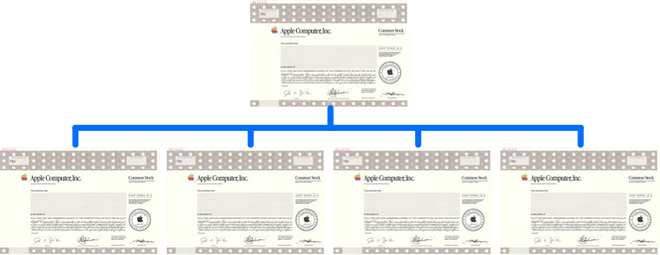Apple’s stock has split five times since the company went public. The stock split on a 4-for-1 basis on August 28, 2020, a 7-for-1 basis on June 9, 2014, and split on a 2-for-1 basis on February 28, 2005, June 21, 2000, and June 16, 1987.
In each of the five times that Apple has split its stock, it was undergoing strong growth in sales and profitability, save for the split in the year 2000, when sales dipped between the dot-com bust and the release of the iPod in October 2001.
It has been over three years since Apple’s last stock split. In the last two splits, the company appears to have intended to bring the share price down to about $100. With a current price in the upper $190s, and setting new all-time highs, Apple’s Board of Directors may be considering another stock split.
Companies issue stock splits for a variety of reasons, but one motivation is to make their shares more accessible to a wider range of investors. Stock splits increase the number of shares outstanding and reduce the price per share, which makes the stock more affordable for smaller investors.
While fractional share purchases are widely available today, they were not always an option. In the past, investors had to buy whole shares, which meant that high-priced stocks were out of reach for many people. Stock splits were a way for companies to lower the price per share and make their stock more accessible to a broader range of investors.
In addition to making their shares more affordable, companies may also issue stock splits to increase liquidity in their stock. By increasing the number of shares outstanding, the trading volume in the stock can increase, which can make it easier for investors to buy and sell shares. Trading volume is not an issue for Apple, the world’s most valuable company.
Stock splits can also be a signal to the market that a company is doing well. When a company announces a stock split, it can be interpreted as a positive sign that the company’s management is confident about the future prospects of the business.
Finally and importantly, Apple is a major component of the Dow Jones index, which is widely used as a benchmark for U.S. equities. Because the Dow is price-weighted, Apple has a significant weight in the Dow. This means that even small changes in Apple’s stock price can have a large impact on the Dow. This can distort the performance of the Dow and make it less accurate as a measure of the overall market. As a result, there is pressure on Apple to periodically split its stock, which would reduce its weighting in the Dow index and increase the Dow’s accuracy in reflecting the overall market.
Apple is currently 12th out of the 30 companies that comprise the Dow Jones Industrial Average with a weight of around 3.5. UnitedHealth Group is, by far, No.1 in Dow weighting at 9.43. The distant No.2 is Goldman Sachs with a weight of 6.77.
So, if weighting and trading volume were the only triggers for a split, Apple is not likely to do so. Still, the company could split its stock at any time simply as a signal of managements’ confidence in the company’s future.
MacDailyNews Note: So, while fractional share purchases are now widely available, companies still issue stock splits to make their shares more accessible to smaller investors, increase liquidity, signal confidence in the future of the business, and, importantly, reduce their price weighting in the widely used DOW index.
Please help support MacDailyNews. Click or tap here to support our independent tech blog. Thank you!
Support MacDailyNews at no extra cost to you by using this link to shop at Amazon.


